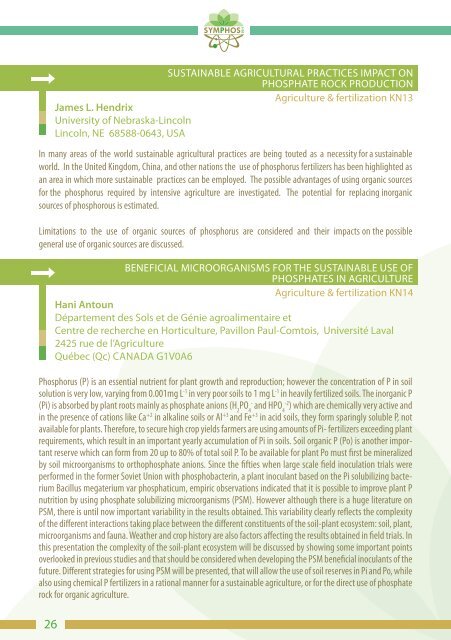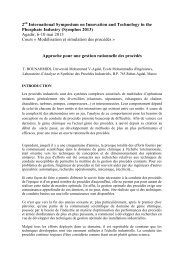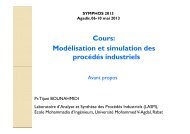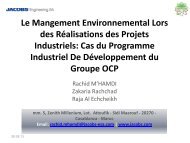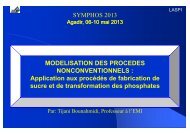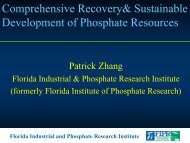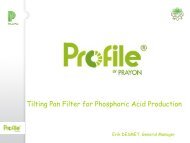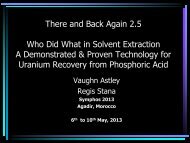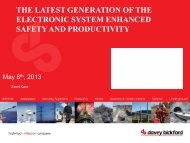Abstract SYMPHOS 2011
Abstract SYMPHOS 2011
Abstract SYMPHOS 2011
Create successful ePaper yourself
Turn your PDF publications into a flip-book with our unique Google optimized e-Paper software.
SUSTAINABLE AGRICULTURAL PRACTICES IMPACT ON<br />
PHOSPHATE ROCK PRODUCTION<br />
Agriculture & fertilization KN13<br />
James L. Hendrix<br />
University of Nebraska-Lincoln<br />
Lincoln, NE 68588-0643, USA<br />
In many areas of the world sustainable agricultural practices are being touted as a necessity for a sustainable<br />
world. In the United Kingdom, China, and other nations the use of phosphorus fertilizers has been highlighted as<br />
an area in which more sustainable practices can be employed. The possible advantages of using organic sources<br />
for the phosphorus required by intensive agriculture are investigated. The potential for replacing inorganic<br />
sources of phosphorous is estimated.<br />
Limitations to the use of organic sources of phosphorus are considered and their impacts on the possible<br />
general use of organic sources are discussed.<br />
BENEFICIAL MICROORGANISMS FOR THE SUSTAINABLE USE OF<br />
PHOSPHATES IN AGRICULTURE<br />
Agriculture & fertilization KN14<br />
Hani Antoun<br />
Département des Sols et de Génie agroalimentaire et<br />
Centre de recherche en Horticulture, Pavillon Paul-Comtois, Université Laval<br />
2425 rue de l’Agriculture<br />
Québec (Qc) CANADA G1V0A6<br />
Phosphorus (P) is an essential nutrient for plant growth and reproduction; however the concentration of P in soil<br />
solution is very low, varying from 0.001mg L-1 in very poor soils to 1 mg L-1 in heavily fertilized soils. The inorganic P<br />
- -2 (Pi) is absorbed by plant roots mainly as phosphate anions (H PO and HPO4 ) which are chemically very active and<br />
2 4<br />
in the presence of cations like Ca +2 in alkaline soils or Al +3 and Fe +3 in acid soils, they form sparingly soluble P, not<br />
available for plants. Therefore, to secure high crop yields farmers are using amounts of Pi- fertilizers exceeding plant<br />
requirements, which result in an important yearly accumulation of Pi in soils. Soil organic P (Po) is another important<br />
reserve which can form from 20 up to 80% of total soil P. To be available for plant Po must first be mineralized<br />
by soil microorganisms to orthophosphate anions. Since the fifties when large scale field inoculation trials were<br />
performed in the former Soviet Union with phosphobacterin, a plant inoculant based on the Pi solubilizing bacterium<br />
Bacillus megaterium var phosphaticum, empiric observations indicated that it is possible to improve plant P<br />
nutrition by using phosphate solubilizing microorganisms (PSM). However although there is a huge literature on<br />
PSM, there is until now important variability in the results obtained. This variability clearly reflects the complexity<br />
of the different interactions taking place between the different constituents of the soil-plant ecosystem: soil, plant,<br />
microorganisms and fauna. Weather and crop history are also factors affecting the results obtained in field trials. In<br />
this presentation the complexity of the soil-plant ecosystem will be discussed by showing some important points<br />
overlooked in previous studies and that should be considered when developing the PSM beneficial inoculants of the<br />
future. Different strategies for using PSM will be presented, that will allow the use of soil reserves in Pi and Po, while<br />
also using chemical P fertilizers in a rational manner for a sustainable agriculture, or for the direct use of phosphate<br />
rock for organic agriculture.<br />
26


